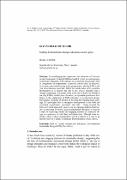| dc.contributor.author | Olweny, Mark R. O. | |
| dc.date.accessioned | 2018-07-26T10:46:43Z | |
| dc.date.available | 2018-07-26T10:46:43Z | |
| dc.date.issued | 2013 | |
| dc.identifier.uri | http://hdl.handle.net/20.500.12280/561 | |
| dc.description.abstract | Acknowledging the importance and relevance of Environ-mental Sustainable Design (ESD) has kindled a shift in contemporary architecture education, with schools of architecture incorporate ESD as components of programmes: in specific course units; as electives; or in some cases transforming entire programmes, placing ESD at the core of architecture curricula. While this would seem to be a positive development, it is evident that this is not always matched with a change in teaching. This paper looks at the use of Rules-of-Thumb in teaching ESD in architecture education, as a possible problem or hindrance to the application of ESD principles in architectural design. The reliance on Rules-of-Thumb as the basis for teaching (and learn-ing) ESD principles fails to recognise developments in the field and associated complexities associated with this. Going beyond the Rules-of-Thumb approach, may be key to engaging students (and fac-ulty) in discourse on ESD as part of architecture education. It could be a basis for exploring context and engaging students in contextual de-sign as a generator of both ideas and information. Through some examples, some of these opportunities will be explored as a way to go beyond Rules-of-Thumb, to stimulate ESD education in East Africa. | en_US |
| dc.language.iso | en | en_US |
| dc.publisher | The Architectural Science Association (ANZAScA), Australia | en_US |
| dc.subject | Rule of Thumb | en_US |
| dc.subject | Architecture Education | en_US |
| dc.subject | Environmental Sustainable Design (ESD), East Africa | en_US |
| dc.subject | East Africa | en_US |
| dc.title | Beyond Rule of Thumb: Kindling Environmental Design Education in East Africa | en_US |
| dc.type | Other | en_US |


